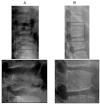Prevalent vertebral fractures among children initiating glucocorticoid therapy for the treatment of rheumatic disorders
- PMID: 20391507
- PMCID: PMC3958950
- DOI: 10.1002/acr.20171
Prevalent vertebral fractures among children initiating glucocorticoid therapy for the treatment of rheumatic disorders
Abstract
Objective: Vertebral fractures are an under-recognized problem in children with inflammatory disorders. We studied spine health among 134 children (87 girls) with rheumatic conditions (median age 10 years) within 30 days of initiating glucocorticoid therapy.
Methods: Children were categorized as follows: juvenile dermatomyositis (n = 30), juvenile idiopathic arthritis (n = 28), systemic lupus erythematosus and related conditions (n = 26), systemic arthritis (n = 22), systemic vasculitis (n = 16), and other conditions (n = 12). Thoracolumbar spine radiograph and dual x-ray absorptiometry for lumbar spine (L-spine) areal bone mineral density (BMD) were performed within 30 days of glucocorticoid initiation. Genant semiquantitative grading was used for vertebral morphometry. Second metacarpal morphometry was carried out on a hand radiograph. Clinical factors including disease and physical activity, calcium and vitamin D intake, cumulative glucocorticoid dose, underlying diagnosis, L-spine BMD Z score, and back pain were analyzed for association with vertebral fracture.
Results: Thirteen vertebral fractures were noted in 9 children (7%). Of these, 6 patients had a single vertebral fracture and 3 had 2-3 fractures. Fractures were clustered in the mid-thoracic region (69%). Three vertebral fractures (23%) were moderate (grade 2); the others were mild (grade 1). For the entire cohort, mean +/- SD L-spine BMD Z score was significantly different from zero (-0.55 +/- 1.2, P < 0.001) despite a mean height Z score that was similar to the healthy average (0.02 +/- 1.0, P = 0.825). Back pain was highly associated with increased odds for fracture (odds ratio 10.6 [95% confidence interval 2.1-53.8], P = 0.004).
Conclusion: In pediatric rheumatic conditions, vertebral fractures can be present prior to prolonged glucocorticoid exposure.
Figures

References
-
- Lien G, Selvaag AM, Flato B, Haugen M, Vinje O, Sorskaar D, Dale K, Egeland T, Forre O. A two-year prospective controlled study of bone mass and bone turnover in children with early juvenile idiopathic arthritis. Arthritis Rheum. 2005;52(3):833–40. - PubMed
-
- Cetin A, Celiker R, Dincer F, Ariyurek M. Bone mineral density in children with juvenile chronic arthritis. Clin Rheumatol. 1998;17(6):551–3. - PubMed
-
- Lien G, Flato B, Haugen M, Vinje O, Sorskaar D, Dale K, Johnston V, Egeland T, Forre O. Frequency of osteopenia in adolescents with early-onset juvenile idiopathic arthritis: a long-term outcome study of one hundred five patients. Arthritis Rheum. 2003;48(8):2214–23. - PubMed
-
- Celiker R, Bal S, Bakkaloglu A, Ozaydin E, Coskun T, Cetin A, Dincer F. Factors playing a role in the development of decreased bone mineral density in juvenile chronic arthritis. Rheumatol Int. 2003;23(3):127–9. - PubMed
Publication types
MeSH terms
Substances
Grants and funding
LinkOut - more resources
Full Text Sources
Medical

